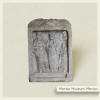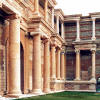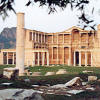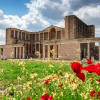Top
Archaeological Sites in Anatolia
Turkey-Türkiye
Ephesus
|
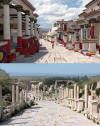
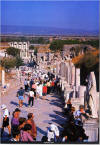 |
UNESCO
World Heritage Sites in Turkey: Ephesus is one of the best-preserved ancient
Ionian cities in the world,
dates back to 12 C BC. The City was an important trade and religious center in antiquity.
Located
within what was once the estuary of the River Kaystros, Ephesus
comprises successive Hellenistic and Roman settlements founded on new
locations, which followed the coastline as it retreated westward.
Excavations have revealed grand monuments of the Roman Imperial period
including the Library of Celsus and the Great Theatre. Little remains of
the famous Temple of Artemis, one of the "Seven Wonders of the World",
which drew pilgrims from all around the Mediterranean. Since the 5th
century, the House of the Virgin Mary, a domed cruciform chapel seven
kilometres from Ephesus, became a major place of Christian pilgrimage.
The Ancient City of Ephesus is an outstanding example of a Roman port
city, with sea channel and harbour basin.




Pergamum (Pergamom, Bergama) is an acropolis. Pergamum was
an administrational center
during the Roman period and
was also famous for its library.
Physician Galen was also born here.
Bergama (Pergamum) (transanatolie.com)
Troy (Truva, Troj) is one of the most famous cities in history.
Troy dates
back to 4th millennium BC. Homer first mentioned the story
of Troy in the Iliad and Odyssey.
One of the most spectacular sites in Turkey especially
at sunset is Mount Nemrut.
Commagene Kingdom
was a strategic crossroad on the important trade routes
between Syria, Mesopotamia and Rome.
Catalhoyuk is one of the most important Neolithic settlements of the world dating back 4th Millenium
BC.
The city was well-planned
and executed. Priene
is a very good example of Greek Architecture
dating back 7th C BC.
In Uluburun, Kas, the Institute of Nautical Archaeology's (INA) shipwreck
excavation in 1980s brought to light one of the wealthiest
and largest known collections of Late Bronze Age items
found in the Mediterranean.
Sardis
was the capital of
Lydia.
In the 7th C BC the Lydians invented the first coinage
in history. The King Croesus controlled most of western
Asia Minor
in 6th C BC.
Hattusas
was the chief center of the
Hittite Empire. The principal
Hittite inscriptions on 10,000 tablets were found here
in
early 20th C.
The ancient city of
Aphrodisias, dedicated to the goddess
of
love Aphrodite. The City has
the best-preserved stadium
in Asia Minor.
Purushanda-Purushattum-Acemhoyuk
|
 |
Acemhöyük (Ancient Anatolian City of Acemhoyuk-Aksaray) (transanatolie.com)
Aşıklıhöyük-Aşıklı
Höyük is an incredible archaeological site with many
groundbreaking finds where you can both witness and experience the
lives of pre-historic people. It was first settled in the
Pre-Pottery Neolithic period, around 8,200 BC. Aşıklı Höyük is the
first known village in Central Anatolia where a hunter-gatherer
society settled down and created a farming community. These people
created amazing adobe (mud-brick) homes which they used for
generations. Today, you can see both the excavations of these
dwellings as well as replicas of these structures rebuilt for
visitors to explore. In addition to the amazing Neolithic
architecture, the site also offers some incredible finds. The first
known brain surgery in history was discovered here. In addition, the
people of Aşıklı Höyük used astounding craftsmanship on the obsidian
mined from the area that archaeologists still cant explain today. A
definite must-see the next time youre in the Aksaray-Cappadocia
region!
(Aşıklı Höyük Archaeological Site,
Aksaray)
Aşıklıhöyük (transanatolie.com)
Asiklihoyuk (transanatolie.com)
Göbekli Tepe (transanatolie.com)
Karahan Tepe (transanatolie.com)

-
TransAnatolie Tour
- A - Group
License N°4938 - The Turkish Ministry of Culture and Tourism
|








